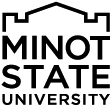By Amanda Duchsherer
Digital Communication Specialist
amanda.duchsherer@minotstateu.edu
MINOT, N.D. – For most, the process of speaking is automatic, a series of complex actions running in our brain with little to no intentional thought. We can thank the extrapyramidal system — a part of the motor system network — for that and many other involuntary actions.
Individuals with Parkinson’s, however, have to learn how to speak without the benefit of that system.
“When you’re lacking dopamine, the firing neurons at that automatic level aren’t working properly,” Lisa Roteliuk ’97/’99, Minot State communication sciences and disorders assistant professor, said. “To say a word, you might have a delay in trying to say it, or it may come out very, very soft. We’re trying to take the process of speaking and move it from the automatic extrapyramidal system to the pyramidal track, which is our intentional system.”
Together, faculty and students involved in the speech pathology graduate program are helping clients learn to speak with intent.
The Communication Disorders Clinic offers a two-part speech therapy program to help individuals with Parkinson’s regain and maintain effective communication: SPEAK OUT!® and LOUD Crowd®.
“Typically, clients with early onset Parkinson’s will meet three times a week when they first start with the SPEAK OUT! ® program. The length of time is variable depending on when they meet dismissal into the LOUD Crowd® group,” said Roteliuk. “The LOUD Crowd® piece is weekly maintenance. The clients meet once a week and it is usually with more than one person. The LOUD Crowd® is built up forever, to make sure they are maintaining progress. If we notice a client is starting to decline as far as intelligibility or peers are having to ask for clarification, we can do another round of SPEAK OUT!®.”
The department was first awarded the National SPEAK OUT! ® and LOUD Crowd® grant through the Parkinson Voice Project in 2018, and the grant was recently awarded again for the fourth year in a row. The grant provides funding for training for faculty and speech pathology graduate students. Additionally, supplies such as sound pressure level meters, therapy manuals, and other materials used in the therapy process are provided through the grant.
Students involved in the graduate program spend time immersed in three different tracks before their externships: assessment, pediatric, and adult. It is when they’re in the midst of their adult track that they have the opportunity to work with patients with Parkinson’s.
“I enjoyed working with my client during my adult clinical rotation with Mrs. Roteliuk in Fall 2020,” said Leanne Wu, who will graduate in May and is currently gaining experience in an externship in Calgary, Alberta. “It was definitely something new to me, as I had no clinical experience in the voice area and knew so little about clients with Parkinson’s disease.
“During and after our sessions, Mrs. Roteliuk gave very specific feedback about enhancing our performance to further improve the client’s progress. She helped us understand the underlying causes of why our client was performing the way they did. Same with the LOUD Crowd® program — it was fun to see how the clients with Parkinson’s interacted and how they made each other grow by giving honest comments. It was sweet to see how they encouraged each other during the group session.”
An important facet to the therapy program is continuous practice.
“When clients come to us, we’re getting them trained to use that intent,” Roteliuk said. “But, as soon as we stop practicing that intentional use, as soon as a client gets out of that habit, if they stop practicing daily, they start going back into that extrapyramidal track for their speaking.
“It’s not the clinical themselves that make or break the whole system, it’s that continued practice.”
Continuing the system meant some quick workarounds when in-person therapy sessions were halted due to the coronavirus pandemic.
“When I was first trained in the SPEAK OUT!® and the LOUD Crowd® grant program, teletherapy wasn’t discussed as main platform for delivering the therapy services,” Roteliuk said. “But during COVID, the director of the Parkinson’s Voice Project started doing live Facebook sessions and then they shifted into teletherapy sessions.
“The main premise behind that move was to make sure you keep patients with Parkinson’s practicing. If you took a month or three months off, depending on the restrictions for your location, patients were going without services.”
Switching to teletherapy meant changes for both clients and students.
“Since we did teletherapy with our client, we adapted a new way to take data,” said Wu. “We used a scale system going from 1, for maximum cues, to 7, independently doing the task with no given cues, to rate our client’s performance on each task. It was cool that we analyzed the scale and assigned a description to each number, so we came up with a cueing system and had a clearer way to rate the client’s performance.”
“I am grateful that I got to work with different professors and learned various programs, like SPEAK OUT!® and the LOUD Crowd®, to help my clients in the future.”
About Minot State University
Minot State University is a public university dedicated to excellence in education, scholarship, and community engagement achieved through
rigorous academic experiences, active learning environments, commitment to public service, and a vibrant campus life.
Published: 04/15/21




